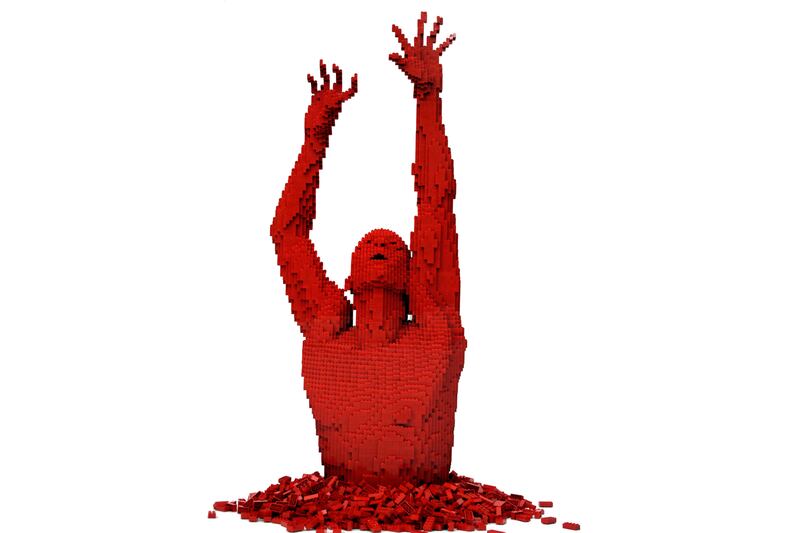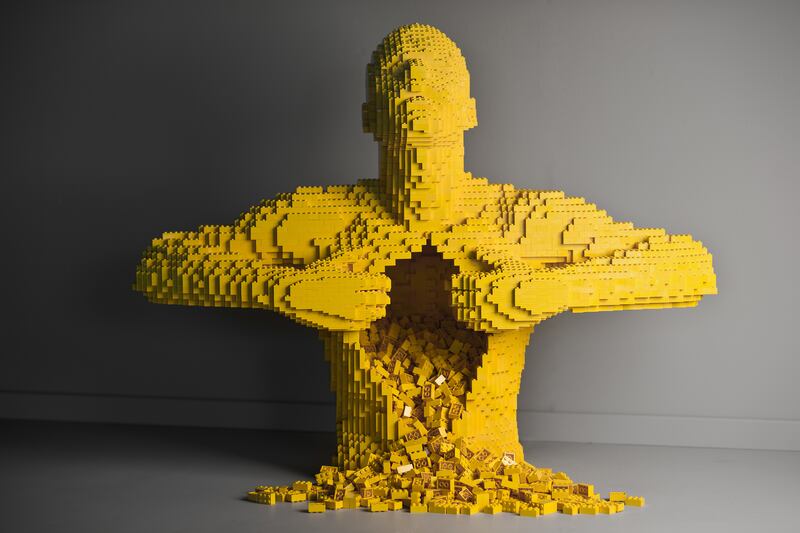It’s the most wonderful, weirdest memory. Remember when you were a kid and you’d play with Lego and, when you were done, you would have circular impressions on your thumbs from pressing the bricks into each other?

Nathan Sawaya, otherwise known as “The Brick Artist,” knows those impressions well—and not just because he has them tattooed on his wrist. “I had a tattoo exactly like that on my thumb, too, but little did I know that the thumb regenerates its skin so fast that it wiped off after a few months,” he tells me. “My tattoo artist expected it to last six months to a year, but given my profession, it was less than three months and it was gone.”
Sawaya’s profession, as it happens, is a sculptor. A Lego sculptor. A Lego sculptor whose exhibition, The Art of the Brick, is breaking attendance records around the world. (And, just in time for the release of The Lego Movie, it is about to return to Manhattan.)
ADVERTISEMENT
Yes, Nathan Sawaya is paid to play with Lego. And yes, it’s every bit as cool as you’d imagine.
Like most of us, Sawaya got his first set of Lego when he was just 5. Like many of us, he tormented his blessedly understanding parents with his playtime career choice as architect. “They did let me have a 36 square foot Lego city in the house!” he remembers. Like some of us, his love of Lego lingered as he entered adulthood, even stowing a container of bricks under his NYU dorm room bed. (His roommates never found out.) Like very few people, he quit his cozy job as a corporate lawyer to pursue his love of art and creation. And like almost none of us, he’s made a second career out of fashioning Lego sculptures.
“Some people go to the gym at the end of the day to unwind, but for me it was all about creating,” Sawaya says. “I was drawing and painting and writing and then I was sculpting.” After doing a series of sculptures using candy, Sawaya challenged himself to create a piece—a self-portrait, as it would happen—using his favorite toy from childhood, Lego bricks. The results were more poignant than he could even imagine.
“I was using bricks from my childhood,” he says. “They were 20 years old and still snapping together perfectly with brand new Lego sets I was buying. There was this crazy aspect about it, that this toy continues on, that it’s recycled through generations and still works. That you can take a toy from the 1970s and it still snaps together with a brand new brick 30, 40 years later is amazing.”
PHOTOS: 20 Amazing Lego Sculptures

While still working at his law firm, Sawaya would post his finished Lego sculptures on a website, brickartist.com. Soon, he was getting commissions to create custom pieces. Then requests started pouring in from all over the world. One day his website crashed because it was getting so many hits, he says, “so I left the law firm to play with toys full time.”
It wasn’t an easy transition. His colleagues and his family thought he was out of his mind. Quit corporate law to play Lego … can you blame them? Other reactions ran the gamut. “Some of my colleagues were jealous because I was following my passion,” Sawaya says. “Others were just confused.” But even after making the decision, it wasn’t all child’s play (heh) to go from the lifestyle of a lawyer making six figures to the lifestyle of an artist, unsure of whether he can pay rent each month.
“In 2007, I got my first solo show,” Sawaya remembers. “At the time I thought it was going to be my last solo show.”
It wasn’t.
Years after making the bold move in pursuit of what most people would consider a very, very niche form of art, Sawaya is seeing his idea to turn a toy into an artistic medium ride a wave of insurgent Lego popularity. Not only is Sawaya’s exhibition more popular than ever (after touring as far away as South Africa, China, and Taiwan, it’s returning to Times Square in February), but The Lego Movie is opening this weekend, already scoring rave reviews and has the second-highest advanced ticket sales of any animated movie ever, according to Fandango.
More than 65 years after children first marveled at those circular, Lego-shaped impressions on their thumbs after building with the bricks, the toy is having a bit of a moment.
“When I started doing this art, even after I had the first exhibition, galleries and owners laughed,” Sawaya remembers. “I had doors slammed in my face.” Now, he’s making replicas of tyrannosaurus rex skeletons that measure over 20 feet in length; blowing people’s minds with uncanny recreations of works like Mona Lisa, Whistler’s Mother, and The Thinker; harboring four or five million bricks between his two studios in L.A. and New York; and, through the success of his exhibition, seeing how universal and instant the appeal of the Lego is.
“When I was in South Africa I was meeting with people who never heard of Lego bricks,” he says. “And yet when I was like, ‘Here they are,’ they immediately got it. They saw the appeal, were snapping bricks and creating their little creations right there immediately.”
Lego’s continued popularity is astounding considering the countless toy fads coming and going over the decades, ever-evolving technology introducing revolutionary new ways to play games every day, and the fact that a toddler who played with one of the first sets is now old enough to retire. Part of that is owed to the simplicity of it, the flash of ecstasy that comes at the sound of two bricks snapping together as you construct buildings with your own two fingers, using your imagination as the only blueprint. (The wonder in the eyes of anyone who sees Sawaya’s work comes from their awe at the wonder of his imagination, seeing the possibility of his sculptures from a pile of Lego bricks.)
The other part of it is the renewed importance of nostalgia in our lives, with an entire “Buzzfeed generation” creating a culture around the celebration of activities and memories that meant a lot to them as kids. The excitement for The Lego Movie certainly speaks to that, as does the reaction to Sawaya’s work.
“I do hear from people at my exhibition about seeing these things made from this toy from their childhood and it brings them back,” he says. “They’ll go and buy a set of Lego from the gift shop because of that nostalgia and seeing it at the art exhibition.” That response bridges generations, too. “I’ve heard from parents who have emailed me and said things like, ‘Hey, we saw your exhibition. After we got home the kids went straight to their room, dug out all their Lego bricks, and we haven’t heard from them for three days. Thank you.’”
So rewarding? Sure. But building 20-foot sculptures out of teeny-tiny Lego bricks can be as tedious as it sounds. Piecing together the (many) ribs on a T-rex skeleton can be a mind-numbing task, and there are times when it seems like the project will never, ever be complete, that Sawaya will be piecing together bricks from now into infinity. That’s when Pandora and a cup of coffee come in handy—as does a reality check.
“Yeah, there are times in a project when it does feel tedious,” he says, “but I always remind myself that I’m playing with toys for a living. This is what I love. It’s not that bad.”
To say the least.





